Long-term monitoring of health inequalities: March 2017
Update of long-term indicators of health inequalities, such as healthy birth weight and alcohol-related hospital admissions.
This document is part of a collection
Headline indicators of Health Inequalities
Premature Mortality
Despite increasing in the past two years, the gap in premature mortality rates between the most and least deprived areas has reduced since 2002. Relative inequalities, however, have widened over the long term.
In 1997, premature mortality rates were 2.7 times higher in the most deprived areas compared to the least deprived; in 2015, rates were 3.7 times higher in the most deprived areas.
Trends in premature mortality
More than 20,000 people in Scotland died before the age of 75 in 2015.
Over the long term there has been a reduction in the mortality rate among under-75s. However, 2015 is the first year covered in this report which has seen an increase in the premature mortality rate.
The age-standardised mortality rate among under-75s in 2015 was 440.5 per 100,000 people. This is a reduction of 32 per cent since 1997, but an increase of four per cent since 2015.
Inequalities in premature mortality, 2015
In 2015, the premature mortality rate in the 10% most deprived areas was 828.6 per 100,000, 3.7 times higher than the rate in the least deprived areas (226.6 per 100,000).
Figure 2.1: All cause mortality amongst those aged <75y by Income-Employment Index Scotland 2015 (European Age-Standardised Rates per 100,000)
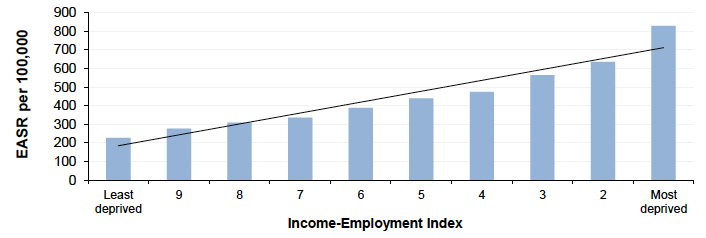
Trends in relative inequalities
The RII is the same in 2015 as in 2014 (both 1.33). However, over the longer term, relative inequalities have increased.
Between 1997 and 2015, premature mortality rates declined by 41% in the least deprived areas, but by only 20% in the most deprived areas in Scotland.
In 1997, premature mortality rates were 2.7 times higher in the most deprived areas compared to the least deprived; in 2015, premature mortality rates were 3.7 times higher in the most deprived areas.
Figure 2.2: Relative Index of Inequality (RII): All cause mortality <75y Scotland 1997-2015

Trends in absolute inequalities
Absolute inequalities in premature mortality reached a peak in 2002. Between 2002 and 2013 there was a general downward trend. Most notably, the absolute gap between the most and least deprived areas reduced every year between 2007 and 2013.
Since 2013 the gap has increased, although it is currently lower than at any point prior to 2010.
Figure 2.3: Absolute Gap: All cause mortality <75y, Scotland 1997-2015 (European Age-Standardised Rates per 100,000)
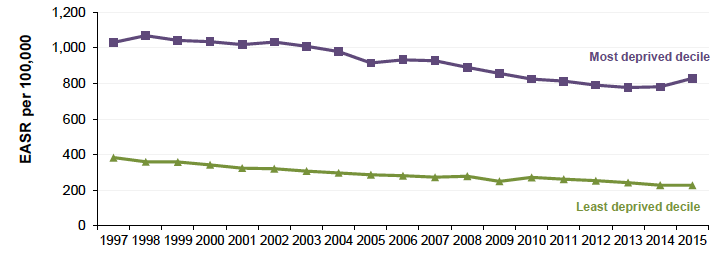
In 2002, the premature mortality rate in the most deprived areas was 1,033.2 per 100,000 and 319.8 per 100,000 in the least deprived areas, a gap of 713.4 per 100,000. In 2015, the gap had reduced to 602.0 per 100,000.
Table 2.1: Trends in premature mortality, 1997-2015
| Year | Number of deaths | Target population size | Rate per 100,000 ( EASR) |
|---|---|---|---|
| 1997 | 26,081 | 4,740,269 | 651.9 |
| 1998 | 25,857 | 4,729,975 | 643.3 |
| 1999 | 25,491 | 4,721,298 | 632.5 |
| 2000 | 24,593 | 4,708,667 | 607.3 |
| 2001 | 24,168 | 4,703,661 | 593.1 |
| 2002 | 24,219 | 4,701,958 | 588.9 |
| 2003 | 23,789 | 4,702,431 | 573.4 |
| 2004 | 22,896 | 4,714,233 | 546.2 |
| 2005 | 22,441 | 4,735,320 | 530.3 |
| 2006 | 22,237 | 4,752,425 | 520.4 |
| 2007 | 22,359 | 4,783,452 | 516.8 |
| 2008 | 22,005 | 4,811,453 | 501.3 |
| 2009 | 21,229 | 4,835,007 | 477.0 |
| 2010 | 20,997 | 4,858,058 | 467.4 |
| 2011 | 20,685 | 4,888,316 | 456.1 |
| 2012 | 20,446 | 4,895,114 | 445.3 |
| 2013 | 20,344 | 4,903,074 | 437.5 |
| 2014 | 19,961 | 4,914,362 | 423.2 |
| 2015 | 20,988 | 4,935,283 | 440.5 |
Mental Wellbeing - adults aged 16+
In 2014/2015, inequalities in mental wellbeing amongst adults improved.
In 2012/2013, adults in the most deprived areas were five times more likely to have below average wellbeing than those in the least deprived areas. In 2014/15 adults in the most deprived areas were only 3 times more likely to have below average wellbeing.
This change was largely driven by an increase in the proportion of adults in the least deprived areas with below average wellbeing.
Trends in mental wellbeing
The mean score on the Warwick-Edinburgh Mental Wellbeing Scale ( WEMWBS) has been fairly static, at 49.8 in 2008/2009 and 49.9 in each of the three measurement periods since.
'Below average' wellbeing has been defined as WEMWBS scores of at least one standard deviation below the mean, equivalent to scores of 41 or lower in all years. The proportion of adults in Scotland who have a below average WEMWBS score has remained at 15% since 2008/2009.
Inequalities in mental wellbeing, 2014/2015
In 2014/2015, 27% of adults in the most deprived areas had below average wellbeing, indicated by a WEMWBS score of 41 or lower. This compared to 9% of adults in the least deprived areas.
Figure 3.1: Proportion of adults (16+ ) with a below average WEMWBS score by Income-Employment Index, Scotland 2014/2015
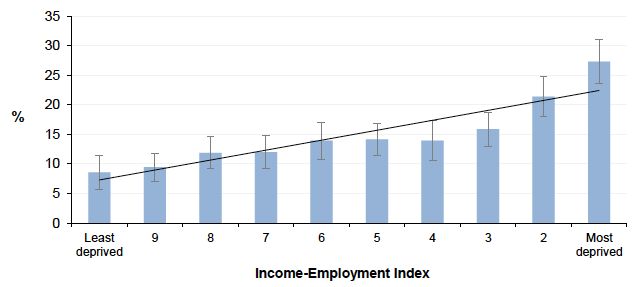
Trends in relative inequalities
The relative index of inequality ( RII) in below average wellbeing for 2014/2015 is the lowest of the four time periods covered in this publication.
In 2014/15 adults in the most deprived areas were approximately 3 times more likely to have below average wellbeing compared to those in the least deprived areas In 2012/2013, adults in the most deprived areas were 5 times more likely to have below average wellbeing.
Figure 3.2: Relative Index of Inequality (RII): Proportion of adults (16+ ) with a below average WEMWBS score Scotland, 2008/2009 - 2014/2015
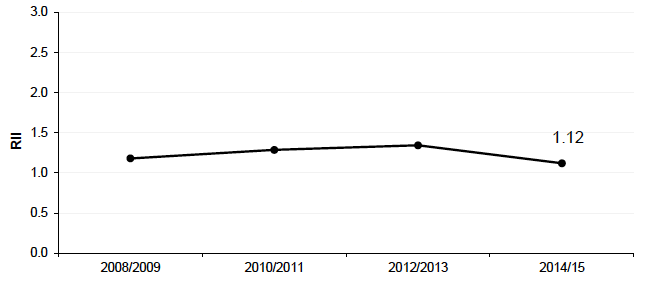
Trends in absolute inequalities
The gap in prevalence of below average wellbeing between those in the most deprived areas and least deprived areas had been widening since 2008/2009. However, in the most recent period the gap returned to a similar level to that recorded in 2010/2011. This was largely driven by a statistically significant increase (from 6% to 9%) in the proportion of adults in the least deprived areas with below average wellbeing.
Figure 3.3: Absolute Gap: Proportion of adults (16+ ) with a below average WEMWBS score Scotland, 2008/2009 - 2014/2015
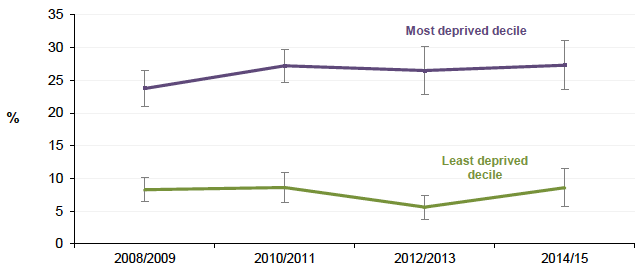
Table 3.1: Trends in mental wellbeing, 2008/2009-2014/2015
| Mean WEMWBS | Below average wellbeing* | |||||
|---|---|---|---|---|---|---|
| Year | Mean WEMWBS score | Lower 95% confidence limit | Upper 95% confidence limit | Proportion of adults with below average wellbeing (%) | Lower 95% confidence limit (%) | Upper 95% confidence limit (%) |
| 2008/2009 | 49.8 | 49.6 | 50.0 | 14.8 | 14.1 | 15.6 |
| 2010/2011 | 49.9 | 49.7 | 50.1 | 15.0 | 14.2 | 15.8 |
| 2012/2013 | 49.9 | 49.7 | 50.2 | 14.9 | 13.9 | 15.8 |
| 2014/2015 | 49.9 | 49.7 | 50.2 | 14.7 | 13.7 | 15.7 |
*indicated by a WEMWBS score of 41 or lower
Contact
Email: Andrew Paterson
There is a problem
Thanks for your feedback